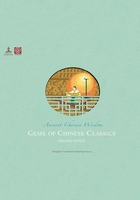
水经注 (shuǐ jīng zhù)
Commentary on the Waterways Classic
Geographer’s ideas flow like a fresh spring
Shui Jing Zhu or “Commentary on the Waterways Classic” has been widely regarded as one of the most comprehensive and well-researched books about rivers, canals and streams in ancient China. It provides rich geographical information about major rivers along with cultural, economical and historical information of areas around these rivers.
Li Daoyuan, author of the book, was a renowned geographer and essayist during the Northern Wei Dynasty (386-534 AD).
Li became interested in rivers, mountains and natural scenery when he was a child. Born into an official’s family, Li spent his childhood in a village surrounded by gorgeous scenes in today’s Hebei Province in northern China.
A small river with pristine water flowed in front of the village and almost every day, Li went to play around the river with his pals.
One year, the river dried up during a devastating drought. Li felt sad and asked his mother, “Where did all the water go?” His mother told him that the water was drunk dry by a river god. The half-baked story didn’t satisfy the boy’s curiosity, but instead kindled his resolve to find out the truth by himself someday.
As a teenager, Li had the opportunity to travel to many places with his father, who was a regional official. On these trips he was fascinated by the beautiful waters and mountains he saw.
As an adult, Li served as a government official in today’s Shanxi, Henan and Hebei provinces. Taking advantage of such opportunities, Li investigated local canals, rivers, streams, mountains and some other geological features. Wherever he visited, he would talk to local elders to record their thoughts on the changes of the natural environment.
During his lifetime, Li traveled to most parts of northern, central and eastern China. The rich data he had collected during such travels had prepared him for future research and for writing his master work, “Commentary on the Waterways Classic.”

In addition to field investigation, Li studied a lot of ancient and contemporary literature and books on geography. He spent a lot of time on classics such as Shan Hai Jing, or “Classic of Mountains and Seas,” and Shui Jing, or “Waterways Classic.” The latter was compiled by Sang Qin during the Three Kingdoms Period (220-280 AD). However, the book recorded only 137 rivers across the country in only about 10,000 Chinese characters.
Li believed the book was incomplete and lacked many essential details. Also, compared with the geographical phenomena that he had observed during his travels, things had changed over time. For instance, many waterways had already changed course and some canals had already fallen into disuse.
Therefore, Li decided to update and expand the content of the original “Waterways Classic” by writing a 40-volume commentary in more than 300,000 Chinese characters and by quoting extensively from the data he had collected from field investigation and more than 430 books that he had arduously studied.
In addition to comprehensive and faithful descriptions of 1,252 rivers in various parts of the country, Li incorporated into his book detailed depictions of soil, vegetation, climate and hydrology as well as economic, human and environmental conditions in regions along those waterways.
For instance, the book listed the names of more than 20,000 places and described the history and architectural styles of more than 30 ancient pagodas, 120 palaces, 260 mausoleums, 26 large monasteries and some famous gardens.
However, China was then divided into the Southern Dynasties (420-589 AD) and the Northern Dynasties (386-581 AD) and Li lived his whole life in the north. Thus his book failed to provide sufficient details about waterways in the country’s south.